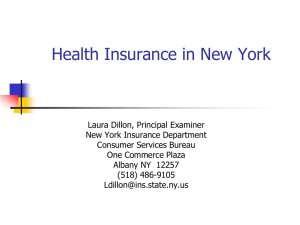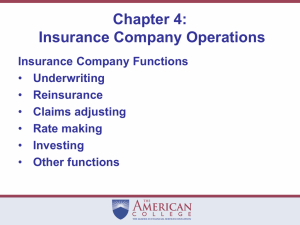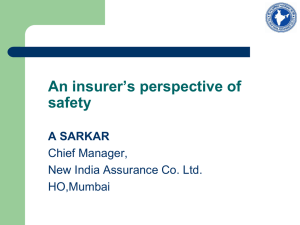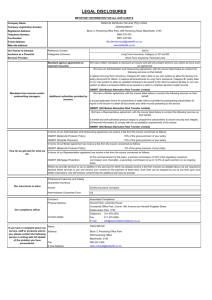Overview of Surplus Lines Insurance Products
advertisement
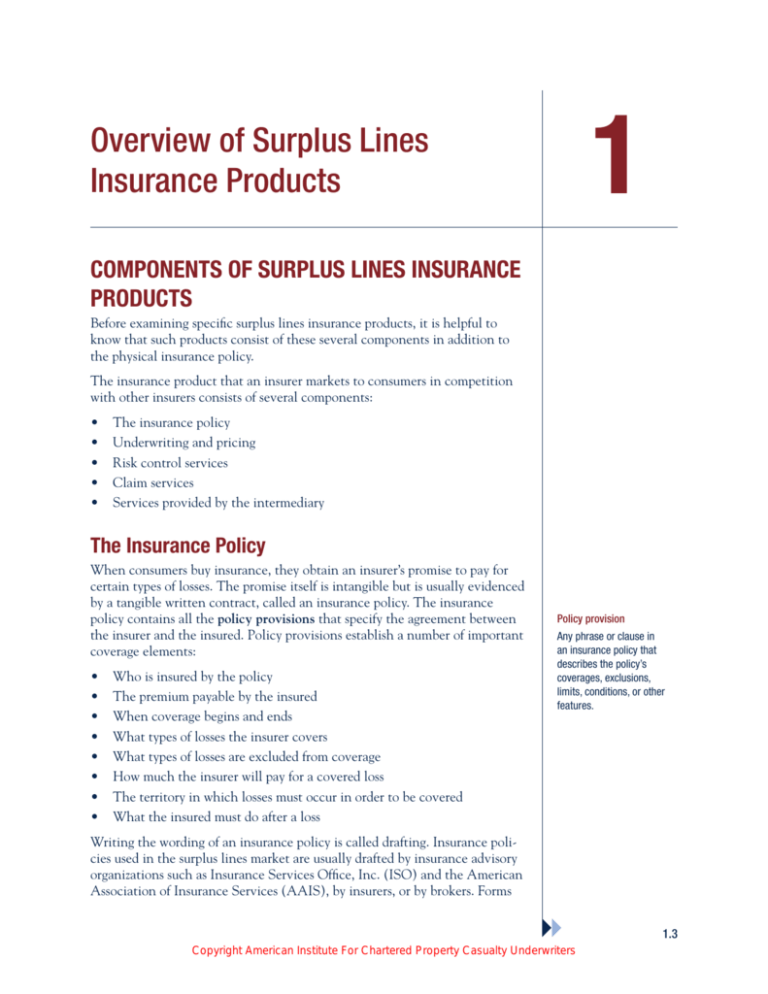
1 Overview of Surplus Lines Insurance Products COMPONENTS OF SURPLUS LINES INSURANCE PRODUCTS Before examining specific surplus lines insurance products, it is helpful to know that such products consist of these several components in addition to the physical insurance policy. The insurance product that an insurer markets to consumers in competition with other insurers consists of several components: • • • • • The insurance policy Underwriting and pricing Risk control services Claim services Services provided by the intermediary The Insurance Policy When consumers buy insurance, they obtain an insurer’s promise to pay for certain types of losses. The promise itself is intangible but is usually evidenced by a tangible written contract, called an insurance policy. The insurance policy contains all the policy provisions that specify the agreement between the insurer and the insured. Policy provisions establish a number of important coverage elements: • • • • • • • • Who is insured by the policy The premium payable by the insured When coverage begins and ends What types of losses the insurer covers What types of losses are excluded from coverage How much the insurer will pay for a covered loss The territory in which losses must occur in order to be covered What the insured must do after a loss Policy provision Any phrase or clause in an insurance policy that describes the policy’s coverages, exclusions, limits, conditions, or other features. Writing the wording of an insurance policy is called drafting. Insurance policies used in the surplus lines market are usually drafted by insurance advisory organizations such as Insurance Services Office, Inc. (ISO) and the American Association of Insurance Services (AAIS), by insurers, or by brokers. Forms 1.3 Copyright American Institute For Chartered Property Casualty Underwriters 1.4 Surplus Lines Insurance Products and endorsements drafted by advisory organizations are generally referred to as “standard” forms and endorsements. Surplus lines insurers often use standard forms and endorsements, although they typically modify them to either broaden or restrict coverage as appropriate for a particular policyholder. This process involves the claim and underwriting personnel of a surplus lines insurer. Often, an exclusion in an admitted insurer’s policy can be turned into a grant of coverage by the surplus lines insurer. Losses can be analyzed to add either a coverage restriction or a coverage grant. For example, many surplus lines insurers have tailored additional insured extensions for the construction class of business to respond to state laws or claim experience. Surplus lines insurers can differentiate their products from those of admitted insurers in this way, because they are not subject to form filing regulations. Despite this freedom, surplus lines insurers seldom draft original policies “from scratch” because the process is a time-consuming, complex task that requires a team of experts, including legal counsel. More typically, when confronted with the need for a new policy form, an intermediary or underwriter will extract suitable provisions from existing policies and draft any additional provisions needed for the new form. In many cases, surplus lines brokers develop insurance programs in cooperation with surplus lines insurers. A significant part of developing the insurance program is selecting appropriate policy forms and endorsements. If no existing forms and endorsements meet the needs of the program, the broker may develop new forms and endorsements, either by drafting them from scratch or, more likely, by using a combination of existing and newly drafted policy provisions. Brokers’ forms exist in another context as well. Numerous businesses, typically larger ones, hire retail insurance brokerages to procure insurance for them. Some brokerages maintain policy forms and endorsements designed to provide the best possible coverage for their clients. Brokers may present these forms to admitted or nonadmitted insurers when applying for insurance on behalf of their clients. In some cases, the brokers’ forms are so favorable to the insured that the insurer will not accept them without modification. For example, a broker’s form may omit certain policy exclusions that an insurer is unwilling to omit. Underwriting and Pricing Underwriting is the process by which an insurer screens applicants for insurance and decides which applicants to accept, what policy provisions to use, and what price to charge for the insurance. Although pricing insurance coverage is actually a component of underwriting, it is such an important aspect of insurance products that it is often discussed separately. Copyright American Institute For Chartered Property Casualty Underwriters Overview of Surplus Lines Insurance Products 1.5 In the simplest case, a policy premium is calculated by multiplying the applicable insurance rate by the number of exposure units. For example, the rate for a particular property insurance policy is $0.50 and the exposure unit is each $100 of insured value. If the limit of insurance (insured value) is $100,000, the policy premium is calculated as $0.50 times 1,000 exposure units equals $500. The policy premium is also affected by the coverage provided by the policy. For example, a high deductible affects both risk selection and pricing. To develop appropriate insurance rates, an insurer begins with loss costs developed by an advisory organization, loss costs based on the insurer’s own loss experience, or a combination. To convert loss costs to rates, the insurer increases the loss costs by adding charges that reflect the insurer’s expenses, contingencies, and profits. An example can illustrate how underwriting, including pricing, can differentiate two insurers’ products. Insurer A and Insurer B both use the same standard policy provisions for insuring commercial general liability (CGL) loss exposures. However, the two insurers have different risk selection standards. An applicant who is accepted by Insurer A for CGL insurance is rejected by Insurer B, because the applicant’s loss history and financial condition do not meet Insurer B’s underwriting standards. Moreover, the two insurers price their CGL insurance differently. In the case of an applicant that is acceptable to both insurers, Insurer A charges more premium than Insurer B to insure the same applicant. Thus, even though both insurers use the same policy forms, they offer different products as a result of their different approaches to risk selection and pricing. Exposure unit A fundamental measure of the loss exposure assumed by an insurer. Rate The price per exposure unit for insurance coverage. Loss costs The portion of the rate that covers projected claim payments and loss adjusting expenses. Advisory organization An independent organization that works with and on behalf of insurers that purchase or subscribe to its services. Contingencies A provision in an insurance rate for losses that could not be anticipated in the loss data. Risk Control Services Insurers frequently provide risk control services to their insureds as part of the insurance product. An insurer may use its own employees or a risk control subsidiary, or it may purchase risk control services from an unaffiliated vendor on a fee basis. The extent of risk control services provided by insurers depends on several factors, including the size of the policy premium, type of operations in which the insured is engaged, type of coverage being offered, quantity and quality of risk control personnel available to the insurer, and insurer’s outlook on providing risk control services. Examples of insureds that can benefit from risk control services are manufacturers, building contractors, and high-value properties. Surplus lines insurers also can use risk control services on smaller risks, through third-party inspection services that evaluate an applicant’s loss exposures during the application process. Copyright American Institute For Chartered Property Casualty Underwriters




